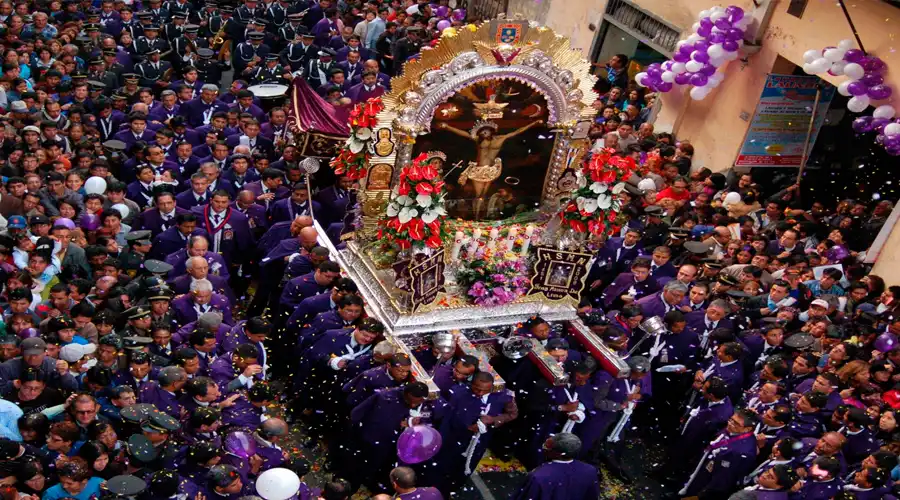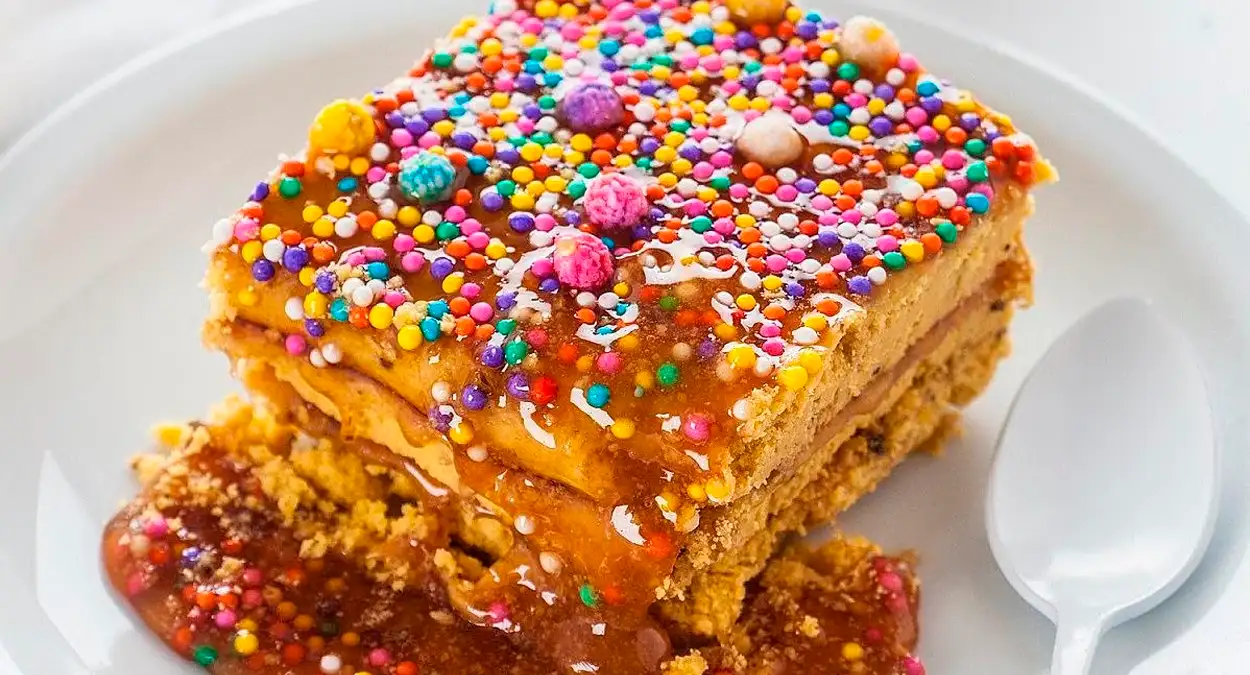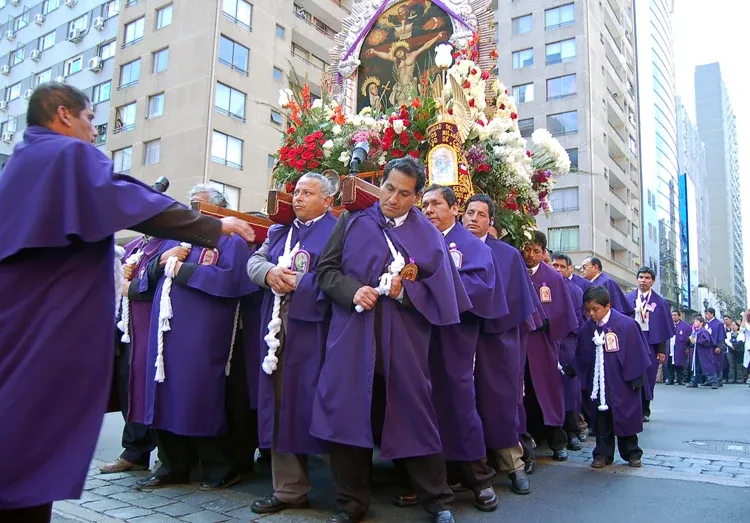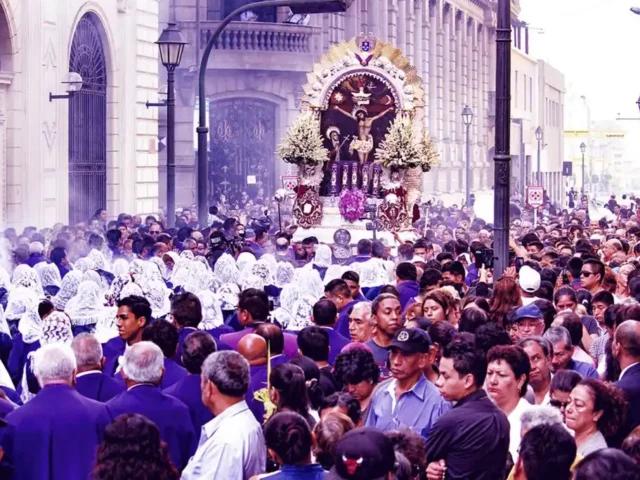Hello! Let me tell you about one of Peru’s most incredible celebrations that happens every October: the Lord of Miracles festival. This tradition has been going on for centuries and it completely changes Lima’s streets, bringing together thousands of people from around the world who want to experience something really special.
Every October, Peru’s capital dresses in purple and the streets come alive with an indescribable energy. This isn’t just a religious procession; it’s a deep encounter with the country’s most authentic roots, where faith, history, and culture intertwine in an extraordinary way. During these days, Lima becomes the stage for the largest procession in all of Latin America, an event that has transcended borders and generations.
Can you picture yourself walking alongside thousands of devotees through the city’s historic streets, breathing in the scent of incense while tasting the delicious turrón de Doña Pepa? It’s an experience that touches all your senses and connects people of different nationalities, ages, and backgrounds in the same emotion. During the “purple month,” as we Peruvians lovingly call it, the entire city transforms and invites you to be part of this celebration that fills every corner with devotion, tradition, and contagious joy. Come and discover why this festival is considered one of the continent’s most important cultural manifestations. Lima awaits you with open arms to experience this unforgettable moment together!
The Lord of Miracles in Peru
The Lord of Miracles is a highly venerated religious figure in Peru, whose image originated in Lima in the 17th century. The painting, depicting the crucified Christ, was painted by an African slave named Benito in 1651 on an adobe wall in the Pachacamilla neighborhood, in the city’s historic center.
The image, known as the “Dark Christ,” survived several devastating earthquakes, increasing popular devotion, as people believed it to be a divine sign of protection. This miraculous event cemented the image as one of the most powerful icons of the Catholic religion in Peru.
The legend
There are many legends surrounding the image of the Lord of Miracles. One of the most popular is the story of the 1746 earthquake, when the Dark Christ was nearly destroyed, but the people of Lima decided to restore it, and the image shone brighter once again. Many stories speak of how the figure of Christ protected the inhabitants of Lima from natural disasters and healed the sick, reinforcing the idea that he is a miraculous figure.
You may be interested: All about Inca language and writing

Lord of miracles festival Peru
The month of October, also known as the “purple month,” becomes one of the most religious months for Peruvians. The Festival of the Lord of Miracles, also known as the Dark Christ, is celebrated primarily in Lima, but its devotion extends throughout the country and abroad. The festivities begin the first weekend of October with the first procession and extend until early November, with the last procession scheduled for November 1st.
When is the festival of the Lord of Miracles?
This year, the procession of the Lord of Miracles in Lima will begin on October 4, 2025, with the first procession starting from the Sanctuary of Las Nazarenas. The festivities will continue throughout October, with various processions and religious activities, and will conclude on November 1, 2025, marking the end of the celebrations in the “purple month.”
Lord of Miracles procession 2025
The procession of the Lord of Miracles is one of the largest in the world and lasts several days. The procession route covers different neighborhoods of Lima, passing by important points in the city such as the Plaza Mayor, the Iglesia del Carmen Church, and the Congress of the Republic. During this journey, thousands of faithful accompany the image, singing religious hymns and praying.
As the procession progresses, devotees stand in its path, asking for favors and giving thanks for the blessings received. The streets of Lima are filled with a solemn yet festive atmosphere, with hundreds of parishioners and onlookers in attendance.
You may be interested: Peru in the summer: 6 best places to visit

Gastronomy during the Festival of the Lord of Miracles
One of the most delicious traditions of the Festival of the Lord of Miracles is the consumption of Doña Pepa’s nougat. This traditional sweet, made with honey, flour, sugar, butter, and seeds, is a culinary emblem of the festival. During the purple month, nougat can be found on almost every street corner in Lima, from small stalls to large stores, and is a delicacy that both locals and tourists enjoy with devotion. Its sweet flavor and smooth texture make it a perfect accompaniment to the celebrations.
Other typical dishes during the festivities
In addition to Doña Pepa’s nougat, during the Festival of the Lord of Miracles, Lima residents and visitors delight in other typical Peruvian dishes that are part of the traditional gastronomy of the purple month. One of the favorites is pan con chicharrón, a typical breakfast or lunch dish consisting of crusty bread accompanied by fried pieces of pork, sweet potato, and salsa criolla, creating a blend of flavors that captures the essence of Peruvian cuisine.
Another very popular dish during these festivities is the Peruvian tamale, prepared with corn dough filled with meat, chicken, or pork, seasoned with spices, and wrapped in banana leaves. These tamales, like pan con chicharrón, are ideal for sharing during processions or at family gatherings and are an excellent example of Peru’s rich culinary tradition.
Where the festival of the Lord of Miracles is celebrated
Although Lima is the epicenter of the festivities of the Lord of Miracles, devotion to the Dark Christ has transcended borders and is celebrated in various parts of Peru and in many countries around the world, where the Peruvian community keeps this very special tradition alive.
Lima
Lima is the heart of the Festival of the Lord of Miracles, and it is where the celebration reaches its peak. During the month of October, the streets of the capital are filled with faithful who participate in the country’s most important processions. The grand procession, which takes place on October 18, runs through Lima’s historic center, passing by emblematic places such as the Plaza Mayor and the Congress of the Republic. In Lima, the fervor for the Moreno Christ is palpable in every corner, from the masses at the Sanctuary of Las Nazarenas to the improvised altars in the streets.
Arequipa
In Arequipa, the Festival of the Lord of Miracles is celebrated with a special devotion that combines religious traditions with the warmth of the white city. Processions run through the main streets of the center, where the faithful gather to pay homage to the Moreno Christ. Arequipa, known for its impressive colonial architecture and the majestic Misti volcano, offers a unique setting for this festival, which is highlighted by the active participation of its residents, who dress in purple and join in the prayers and songs.
Trujillo
In northern Peru, Trujillo also celebrates the Festival of the Lord of Miracles with great fervor. Processions wind through the streets of the historic city center, and the atmosphere of unity and devotion permeates every corner. The festival in Trujillo has a unique atmosphere, combining the religious nature of the event with the warmth of the people and the beauty of the city. The people of Trujillo dress in purple to participate in mass and the most significant moments of the procession.
Cusco
In Cusco, the city that was once the capital of the Inca Empire, the Festival of the Lord of Miracles takes on a special touch, blending the Catholic faith with the ancient traditions of the Andean region. Although Cusco doesn’t celebrate a procession as large as Lima’s, the devotion is equally intense. The Cusco community unites in masses and celebrations in honor of the Dark Christ, uniting two worlds: the Christian faith and the beliefs of the indigenous peoples. In Cusco’s churches, the faithful participate in ceremonies that merge religious rituals and local customs.
Moquegua
In Moquegua, the Festival of the Lord of Miracles is also celebrated with great devotion. The procession winds through the main streets of the city, where the people of Moquegua dress in purple and gather to pay homage to the Dark Christ. Although Moquegua isn’t as well-known as other cities for this festival, the community’s participation is equally significant. The celebrations in Moquegua are an opportunity for the region’s inhabitants to unite in faith and tradition, sharing moments of prayer and devotion to their patron saint.
You may be interested: Visiting Cusco in October

How to participate in the Lord of Miracles procession
The first time I saw the Lord of Miracles procession, I was completely blown away. Thousands of people dressed in purple walking silently through Lima’s streets, carrying an image that weighs more than a ton. I didn’t understand anything, but something told me I had to be part of this. learned there are right and wrong ways to do it and here’s what you really need to know.
1. Wear purple (but not just any purple)
It’s not just throwing on a purple t-shirt and calling it good. The color has to be specific: Nazarene purple, which is darker than regular purple.
What actually works:
- Nazarene purple shirt or polo
- Dark pants (black or navy blue)
- Comfortable shoes (you’ll walk between 4 and 6 hours)
- Hat or umbrella for the sun
- Common mistake: I saw tourists in fluorescent purple thinking it would work. People looked at them weird. The color matters because it represents penance, not fashion.
2. Attend the preparatory masses
The October masses aren’t optional if you want to understand the procession. I thought I could just show up on the main day and participate. Big mistake.
Real schedule:
- First week of October: preparatory masses
- Second week: main novena
- Third week: grand procession
- Fourth week: closing procession
- Where to go: Las Nazarenas church (Jr. Huancavelica 515, Downtown Lima) is the center of everything. Get there 30 minutes early because it fills up completely.
The masses last between 60 and 90 minutes. The priest explains the history, specific prayers, and procession rules. Without this preparation, you’ll be lost on the main day.
3. Join the procession
As a spectator: Stand on the sidewalks of the official route. The best spots are:
- Plaza de Armas (arrive at 6 AM)
- Jirón de la Unión (fewer people, better view)
- La Merced church (emotional arrival)
- As a walking participant: You can walk behind the andas without special permission, but:
- Don’t use your phone during the route
- Join the chants
- Keep the pace slow and solemn
- If you get tired, leave the group orderly
Hymn to the Lord of Miracles
Lord of Miracles, to You we come in procession,
Your faithful devotees, to implore Your blessing. (repeat)
Beacon that guides, grant our souls
faith, hope, and charity,
may Your divine love enlighten us,
and make us worthy of Your goodness…
4. Participate in parallel activities
Each neighborhood organizes its own food fair. The biggest one is in Downtown Lima, specifically on block 5 of Jirón Huancavelica.
Cultural activities:
- Creole music concerts at Plaza San Martín
- Photography exhibitions at Lima’s Cultural Center
- Turrón-making workshops at local markets
- My recommendation: Don’t try to do everything in one day. My first year I wanted to go to three different fairs and ended up exhausted without enjoying any.
5. Eat the traditional food
Turrón de Doña Pepa: Don’t buy just anywhere. The best ones are at:
- San Antonio Pastry Shop (Miraflores)
- El Chalán Candy Store (Downtown)
- Authorized stands during the procession (look for the municipal permit)
Pan con chicharrón: Sold from carts throughout the route, but the tastiest ones are at:
- La Lucha Sanguchería (several locations)
- Plaza de Armas stands early in the morning
Conclusion about the Lord of Miracles
The turrón vendors calling out, families singing together, people from everywhere walking the same path. You came as a tourist but you’re leaving with something different, something that feels like you actually touched Peru instead of just visiting it. When you get home and tell people about the Lord of Miracles, you won’t just describe what you saw. You’ll talk about how it felt to walk those streets, taste that sweet turrón, and be surrounded by all that energy. October in Lima changes people. Maybe that’s why so many come back year after year, or why this celebration has lasted so long. Some things you just have to experience to understand.


